Locomotion and Movement NCERT
Quiz Summary
0 of 45 Questions completed
Questions:
Information
You have already completed the quiz before. Hence you can not start it again.
Quiz is loading…
You must sign in or sign up to start the quiz.
You must first complete the following:
Results
Results
0 of 45 Questions answered correctly
Your time:
Time has elapsed
You have reached 0 of 0 point(s), (0)
Earned Point(s): 0 of 0, (0)
0 Essay(s) Pending (Possible Point(s): 0)
Categories
- Not categorized 0%
- 1
- 2
- 3
- 4
- 5
- 6
- 7
- 8
- 9
- 10
- 11
- 12
- 13
- 14
- 15
- 16
- 17
- 18
- 19
- 20
- 21
- 22
- 23
- 24
- 25
- 26
- 27
- 28
- 29
- 30
- 31
- 32
- 33
- 34
- 35
- 36
- 37
- 38
- 39
- 40
- 41
- 42
- 43
- 44
- 45
- Current
- Review
- Answered
- Correct
- Incorrect
-
Question 1 of 45
1. Question
1 point(s)Select the correct option.
CorrectIncorrectHint
(a)
-
Question 2 of 45
2. Question
1 point(s)Match the following columns and select the correct option.
\(
\begin{array}{|l|l|l|l|}
\hline & \text { Column-I } & & \text { Column-II } \\
\hline \text { (a) } & \begin{array}{l}
\text { Floating } \\
\text { Ribs }
\end{array} & \text { (i) } & \begin{array}{l}
\text { Located between second and } \\
\text { seventh ribs }
\end{array} \\
\hline \text { (b) } & \text { Acromion } & \text { (ii) } & \text { Head of the humerus } \\
\hline \text { (c) } & \text { Scapula } & \text { (iii) } & \text { Clavicle } \\
\hline \text { (d) } & \begin{array}{l}
\text { Glenoid } \\
\text { cavity }
\end{array} & \text { (iv) } & \text { Do not connect with the sternum } \\
\hline
\end{array}
\)
Options:
\(
\begin{array}{|l|l|l|l|l|}
\hline & \text { (a) } & \text { (b) } & \text { (c) } & \text { (d) } \\
\hline 1 . & \text { (i) } & \text { (iii) } & \text { (ii) } & \text { (iv) } \\
\hline 2 . & \text { (iii) } & \text { (ii) } & \text { (iv) } & \text { (i) } \\
\hline 3 . & \text { (iv) } & \text { (iii) } & \text { (i) } & \text { (ii) } \\
\hline 4 . & \text { (ii) } & \text { (iv) } & \text { (i) } & \text { (iii) } \\
\hline
\end{array}
\)CorrectIncorrectHint
(c)
-
Question 3 of 45
3. Question
1 point(s)The clavicle articulates with:
CorrectIncorrectHint
(d)
-
Question 4 of 45
4. Question
1 point(s)Identify the correct statement regarding human ribs:
CorrectIncorrectHint
(a)
2.❌ Incorrect
- Floating ribs (11th and 12th pairs) do not have anterior attachment to the sternum.
- But they are attached posteriorly to the thoracic vertebrae.
- So saying “do not have any attachments” is wrong.
3.❌ Incorrect
- Human ribs are bicephalic — they have two heads (capitulum and tuberculum) that articulate with the thoracic vertebrae.
- Tricephalic refers to three-headed structures, which is not the case here.
4.❌ Incorrect
- Vertebrochondral ribs (8th to 10th) are false ribs, not true ribs.
- Only the 1st to 7th pairs are true ribs.
-
Question 5 of 45
5. Question
1 point(s)Select the correct statement regarding the specific disorder of muscular or skeletal system.
CorrectIncorrectHint
(b)
1❌ Incorrect
- Muscular dystrophy is not age-related.
- It is a genetic disorder characterized by progressive weakening and degeneration of skeletal muscles, not shortening
3.❌ Incorrect
- Myasthenia gravis is indeed an autoimmune disorder, but it does not inhibit sliding of myosin filaments.
- Instead, it affects the neuromuscular junction, where antibodies block acetylcholine receptors, leading to muscle weakness
4.❌ Incorrect
- Gout is caused by deposition of uric acid crystals, not calcium, in joints.
- This leads to inflammation, pain, and swelling, especially in the big toe.
-
Question 6 of 45
6. Question
1 point(s)Which one of the following is the correct description of a certain part of a normal human skeleton?
CorrectIncorrectHint
(d)
-
❌ Incorrect
-
The first vertebra is the atlas, not the axis.
-
-
❌ Incorrect
- Floating ribs are the 11th and 12th pairs, not the 9th and 10th.
- The 8th to 10th pairs are false ribs, which attach indirectly to the sternum via cartilage.
3. ❌ Incorrect
- The glenoid cavity is part of the scapula and articulates with the head of the humerus (upper arm bone), not the thigh bone.
- The thigh bone (femur) articulates with the acetabulum of the pelvis.
-
Question 7 of 45
7. Question
1 point(s)Assertion: Smooth muscle is fundamentally different from skeletal muscle and cardiac muscle.
Reason: Smooth muscle is an involuntary non-striated muscle.CorrectIncorrectHint
(a)
-
Question 8 of 45
8. Question
1 point(s)During muscular contraction, which of the following events occur?
(a) ‘H’ zone disappears
(b) ‘A’ band widens
(c) ‘I’ band reduces in width
(d) Myosin hydrolyzes ATP, releasing the ADP and \( \mathrm{P}_{\mathrm{i}} \)
(e) Z-lines attached to actins are pulled inwards
Choose the correct answer from the options given below.CorrectIncorrectHint
(c)
-
Question 9 of 45
9. Question
1 point(s)Immediately after the motor neuron passes an impulse to a muscle fiber:
CorrectIncorrectHint
(a)
-
Question 10 of 45
10. Question
1 point(s)Which of the following movements can be seen in a human body?
I. Amoeboid
II. Ciliary
III. FlagellarCorrectIncorrectHint
(d)
-
Question 11 of 45
11. Question
1 point(s)With respect to the red muscle fibers [Type I], the white muscle fibers [Type II] are richer in:
CorrectIncorrectHint
(c)
-
Question 12 of 45
12. Question
1 point(s)During muscle contraction, the part that does not get shortened in length is labeled as the letter:
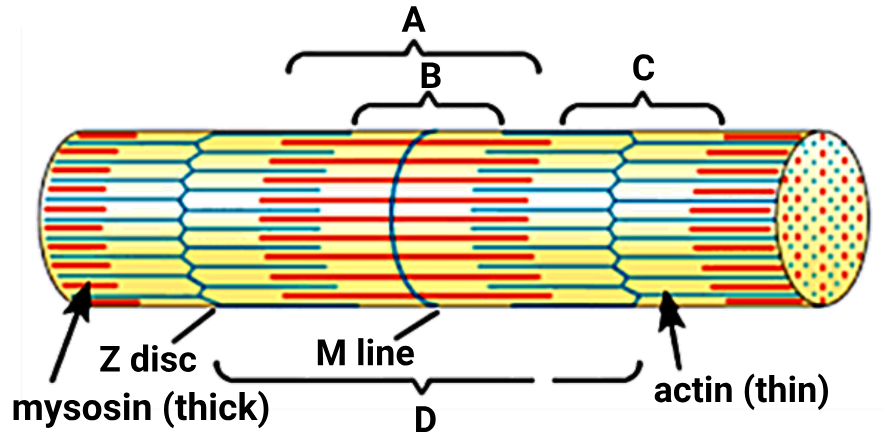 CorrectIncorrect
CorrectIncorrectHint
(a)
- A – The dark central band
- B – The lighter region inside A-band
- C – The light band at either end, near the Z-line
- D – The line at the boundary of each sarcomere
✅ Correct Answer: A (A-band)
✅ Explanation:
- A-band contains the full length of thick (myosin) filaments.
- It remains the same during contraction.
- The I-band and H-zone shorten or disappear.
- The Z-lines move closer together.
-
Question 13 of 45
13. Question
1 point(s)Consider the following statements:
I. The head of myosin is made of LMM and the tail is made of HMM
II. F Actin is monomeric while G actin is polymeric
III. Tropomyosin is composed of three globular proteins.
The incorrect statements are:CorrectIncorrectHint
(d)
-
Question 14 of 45
14. Question
1 point(s)Select the correct match for the parts labeled as A, B, C and D in the given diagram of a sarcomere:
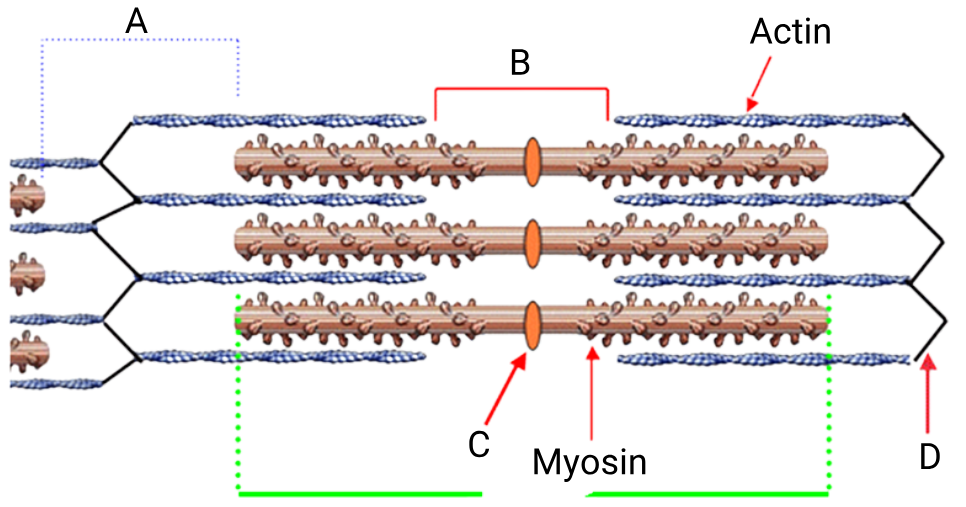
\(
\begin{array}{|l|l|l|l|l|}
\hline & \text { A } & \text { B } & \text { C } & \text { D } \\
\hline \text { 1. } & \text { I band } & \text { A band } & \text { H zone } & \text { M line } \\
\hline \text { 2. } & \text { I band } & \text { H zone } & \text { M line } & \text { Z line } \\
\hline \text { 3. } & \text { A band } & \text { I band } & \text { Z line } & \text { M line } \\
\hline \text { 4. } & \text { H zone } & \text { I band } & \text { M line } & \text { Z line } \\
\hline
\end{array}
\)CorrectIncorrectHint
(b)
-
Question 15 of 45
15. Question
1 point(s)As the distance from Z line to Z line decreases, which bands shorten in a sarcomere?
CorrectIncorrectHint
(a)
-
Question 16 of 45
16. Question
1 point(s)All the following regarding red muscle fibers are true except:
CorrectIncorrectHint
(d)
-
Question 17 of 45
17. Question
1 point(s)During relaxation of a skeletal muscle:
CorrectIncorrectHint
(d)
-
Question 18 of 45
18. Question
1 point(s)What type of muscles do you expect to find in the inner walls of hollow visceral organs?
CorrectIncorrectHint
(a)
-
Question 19 of 45
19. Question
1 point(s)During muscle contraction, when the myosin head releases ADP and iP it:
CorrectIncorrectHint
(c)
This answer is according to NCERT reference
✅ Option 2: Pulls actin toward M-line
This is the actual mechanical action during the power stroke.
When ADP and Pi are released, the myosin head tilts and pulls actin inward.
This is functionally correct and matches muscle physiology.✅ Option 3: Goes back to its relaxed state
This line is directly written in NCERT.
It refers to the bending of the myosin head after ADP and Pi release.
Though incomplete, NEET prefers this due to exact NCERT wording -
Question 20 of 45
20. Question
1 point(s)Identify the correct statements regarding the protein shown in the given diagram:
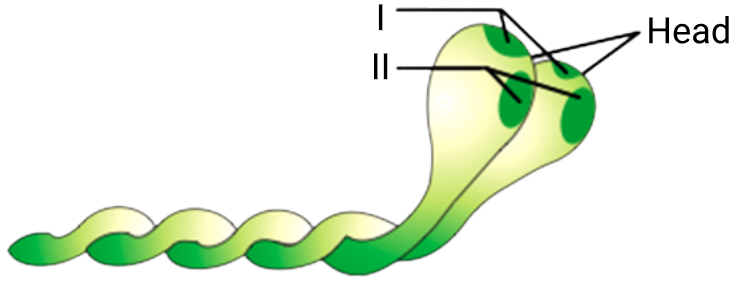
A: I is the active site to which the head of myosin binds during muscle contraction.
B: II is the site for ATP molecule.
C: The head shown has an ATPase activity.CorrectIncorrectHint
(c)
- Label I – This represents the actin-binding site.
- Label II – This represents the ATP-binding site.
A: I is the active site to which the head of myosin binds during muscle contraction.
❌ Incorrect – The myosin head binds to actin, not the other way around.
Also, myosin has the head with the binding site for actin, not the other way around. -
Question 21 of 45
21. Question
1 point(s)The correct statement regarding myofibril would be:
CorrectIncorrectHint
(c)
-
Question 22 of 45
22. Question
1 point(s)What happens during the contraction of a skeletal muscle fiber?
CorrectIncorrectHint
(b)
1.❌ Incorrect
Neither actin nor myosin filaments shorten. They slide past each other during contraction.3.❌ Incorrect
Correct that actin stays same length — but myosin does NOT shorten.4.❌ Incorrect
They slide but do not change in length. -
Question 23 of 45
23. Question
1 point(s)Identify the correct statement regarding the protein shown in the given figure:
 CorrectIncorrect
CorrectIncorrectHint
(a)
-
Question 24 of 45
24. Question
1 point(s)Cross bridge formation during muscle contraction involves:
CorrectIncorrectHint
(d)
-
Question 25 of 45
25. Question
1 point(s)Muscle:
I: is derived from embryonic endoderm
II: constitutes about 40-50 percent of human bodyCorrectIncorrectHint
(b)
Statement I: Muscle is derived from embryonic endoderm
❌ Incorrect
Muscles are derived from the mesoderm, not the endoderm.🔹 NCERT clearly states: “All muscles in the body are mesodermal in origin.”
-
Question 26 of 45
26. Question
1 point(s)Regarding a skeletal muscle fibre:
I: It is a syncytium.
II: It has sarcoplasmic reticulum [a type of smooth ER] that stores calcium.CorrectIncorrectHint
(c)
-
Question 27 of 45
27. Question
1 point(s)Identify the incorrect statement regarding a sarcomere:
CorrectIncorrectHint
(d)
❌ Incorrect
-
Actin and myosin are arranged parallel to the longitudinal axis of myofibrils, not perpendicular.
-
The sarcomere runs longitudinally, and the filaments run along it.
-
Question 28 of 45
28. Question
1 point(s)Which of the following leads to removal of masking of active sites for mysosin during muscle contraction?
CorrectIncorrectHint
(b)
-
Question 29 of 45
29. Question
1 point(s)Consider the following two statements:
Statement I: Red fibres are ‘red’ due to large amount of myoglobin.
Statement II: Red muscles are also called as aerobic muscles.CorrectIncorrectHint
(b)
-
Statement II explains function (aerobic capacity)
-
Statement I explains color (due to myoglobin)
➡ The reason red fibres are red is due to myoglobin, not because they are aerobic.
Being aerobic is a result of having mitochondria and myoglobin, but does not explain the color directly -
Question 30 of 45
30. Question
1 point(s)The given figure shows stages in cross bridge formation, rotation of head and breaking of cross bridge during muscle contraction. Select the correct match for A, B and C from the codes given:

\(
\begin{array}{|l||l|l|}
\hline \text { I. Sliding or rotation } & \text { (i) } & \text { A } \\
\hline \text { II. Breaking of cross bridge } & \text { (ii) } & \text { B } \\
\hline \text { III. Formation of cross bridge } & \text { (iii) } & \text { C } \\
\hline
\end{array}
\)Codes:
\(
\begin{array}{|l|l|l|l|}
\hline & \text { I } & \text { II } & \text { III } \\
\hline 1 . & \text { B } & \text { A } & \text { C } \\
\hline 2 . & \text { B } & \text { C } & \text { A } \\
\hline 3 . & \text { A } & \text { B } & \text { C } \\
\hline 4 . & \text { C } & \text { A } & \text { B } \\
\hline
\end{array}
\)CorrectIncorrectHint
(a)
-
Question 31 of 45
31. Question
1 point(s)Consider the following two statements:
I: Repeated activation of muscles can lead to fatigue.
II: Repeated activation of muscles can lead to accumulation of lactic acid.CorrectIncorrectHint
(a)
-
Question 32 of 45
32. Question
1 point(s)The total number of vertebrosternal and vertebrochondral ribs in human body respectively are:
CorrectIncorrectHint
(b)
-
Question 33 of 45
33. Question
1 point(s)The total number of phalanges in the human body are:
CorrectIncorrectHint
(c)
14 in each Limb . Four Lims having 56
-
Question 34 of 45
34. Question
1 point(s)The axial skeleton in human beings include:
CorrectIncorrectHint
(a)
-
Question 35 of 45
35. Question
1 point(s)The highest position in the human skull is occupied by:
CorrectIncorrectHint
(d)
-
Question 36 of 45
36. Question
1 point(s)Which of the following is not correct regarding scapula?
I. It is situated in the dorsal part of the thorax between the second and the seventh ribs.
II. Clavicle articulates with the acromion process of scapula.CorrectIncorrectHint
(c)
-
Question 37 of 45
37. Question
1 point(s)Identify the correct statements regarding the given two figures:
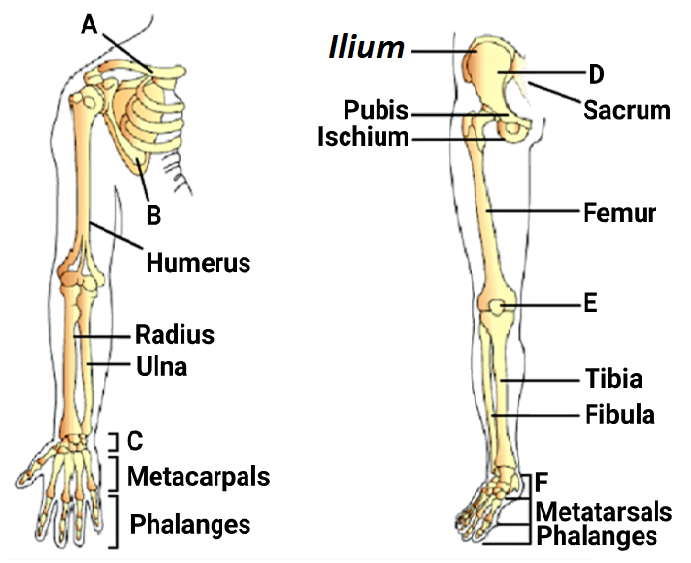
I. A is a part of the pectoral girdle and is commonly called as the collar bone.
II. B is the scapula, a part of the pectoral girdle, which directly articulates with the breast bone, sternum.
III. C represents carpal bones and the type of synovial joint seen between them is the saddle joint.
IV. D is the coxal bone and three such bones fuse to form the pelvic girdle.
V. E is patella that is also called as the knee cap.
VI. F represents tarsals and they are eight in number.CorrectIncorrectHint
- ✅ I. A is a part of the pectoral girdle and is commonly called the collar bone.
- Correct — Clavicle is part of the pectoral girdle and is called the collar bone.
- II. ✖ Incorrect — Scapula does NOT articulate with sternum. Only clavicle does.
🔹 NCERT clearly says clavicle connects scapula to sternum indirectly. - III,✖ Incorrect —C = metacarpals, not carpals
- Saddle joint is between carpal & metacarpal of thumb, not between carpals
- IV. ✖ NEET Prep marks this wrong, because:
- One coxal bone = fusion of 3 bones (ilium, ischium, pubis) ✅
- But pelvic girdle is formed by 2 coxal bones + sacrum
🔹 So technically, “three such bones” forming pelvic girdle is misleading in NEET’s superficial view. - ✅ V. E is patella (knee cap)
- ✔ Correct — Clearly labeled and accurate.
- VI.✖ Incorrect
- F is metatarsals, not tarsals
- Also, tarsals = 7, carpals = 8
-
Question 38 of 45
38. Question
1 point(s)The ribs in humans:
I: have two articulation surfaces on its dorsal end and are hence called bicephalic.
II: connect to the sternum directly or indirectly with the help of hyaline cartilage.CorrectIncorrectHint
(c)
-
Question 39 of 45
39. Question
1 point(s)Identify the incorrect statement:
CorrectIncorrectHint
(b)
Metacarpal and Metatarsal are equal in number which is 5 . Given statement is correct for carpel and tarsal
-
Question 40 of 45
40. Question
1 point(s)The given figure shows the bones of the human rib cage. All the following statements will be correct regarding the human ribs except:
I. Human ribs are dicondylic
II. A represents the vertebra-sternal ribs
III. B represents the vertebra-chondral ribs
IV. C are the false ribs
V. The costal cartilages shown are hyaline cartilages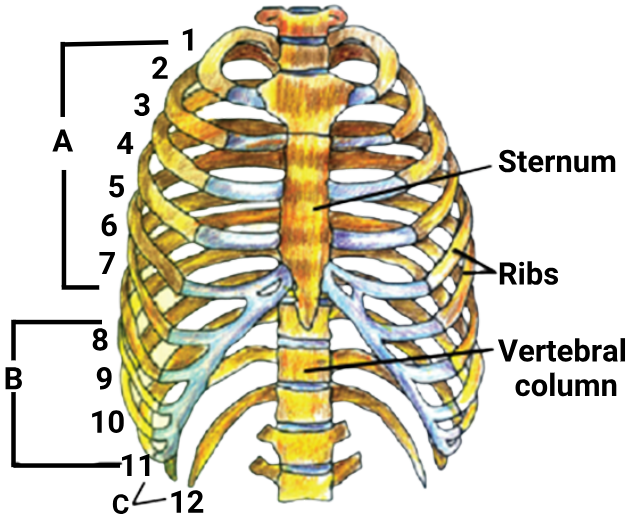 CorrectIncorrect
CorrectIncorrectHint
(d)
❌ I. Human ribs are dicondylic
- Incorrect
- “Dicondylic” refers to skull attachment (two occipital condyles), not ribs.
- Ribs articulate with vertebrae via facets, not dicondyles.
❌ IV. C are the false ribs
- Incorrect (This is a trick point!)
- Ribs 11 & 12 are floating ribs, which are a subtype of false ribs, but not the only false ribs.
- False ribs = 8th to 12th, so C = only part of them, not all.
- Saying “C are the false ribs” is thus incomplete/misleading.
-
Question 41 of 45
41. Question
1 point(s)The type of cartilage present in pubic symphysis is:
CorrectIncorrectHint
(c)
-
Question 42 of 45
42. Question
1 point(s)Match List-I with List-II
\(
\begin{array}{|c|l|}
\hline
\textbf{List-I} & \textbf{List-II} \\
\hline
\text{(a) Scapula} & \text{(i) Cartilaginous joints} \\
\text{(b) Cranium} & \text{(ii) Flat bone} \\
\text{(c) Sternum} & \text{(iii) Fibrous joints} \\
\text{(d) Vertebral column} & \text{(iv) Triangular flat bone} \\
\hline
\end{array}
\)
Choose the correct answer from the options given below.
\(
\begin{array}{|c|c|c|c|c|}
\hline & \text { (a) } & \text { (b) } & \text { (c) } & \text { (d) } \\
\hline 1 . & \text { (iv) } & \text { (ii) } & \text { (iii) } & \text { (i) } \\
\hline 2 . & \text { (iv) } & \text { (iii) } & \text { (ii) } & \text { (i) } \\
\hline 3 . & \text { (i) } & \text { (iii) } & \text { (ii) } & \text { (iv) } \\
\hline 4 . & \text { (ii) } & \text { (iii) } & \text { (iv) } & \text { (i) } \\
\hline
\end{array}
\)CorrectIncorrectHint
(b)
-
Question 43 of 45
43. Question
1 point(s)Consider the given statements regarding the human vertebral column:
I. In adults, it is differentiated into cervical [7], thoracic [12], lumbar [5], sacral [1-fused] and coccygeal [1-fused] regions.
II. The first vertebra is called as axis and it articulates with the occipital condyles.
III. The spinal cord runs through a neural canal.
IV. It protects the spinal cord, supports the head and serves as the point of attachment for the ribs and musculature of the back.
The correct statements include:CorrectIncorrectHint
(d)
The first vertebra is called as Atlas.
-
Question 44 of 45
44. Question
1 point(s)Match each item in Column I with one in Column II and select the correct match from the codes given:
\(
\begin{array}{|l|l|l|l|}
\hline & \text { Column I } & & \text { Column II } \\
\hline \text { A } & \text { Myasthenia gravis } & \text { P } & \text { Auto-immune } \\
\hline \text { B } & \text { Arthritis } & \text { Q } & \text { Inflammation of joints } \\
\hline \text { C } & \text { Tetany } & \text { R } & \text { Low calcium in body fluids } \\
\hline \text { D } & \text { Osteoporosis } & \text { S } & \text { Low levels of oestrogen } \\
\hline
\end{array}
\)
Codes:
\(
\begin{array}{|l|l|l|l|l|}
\hline & \text { A } & \text { B } & \text { C } & \text { D } \\
\hline 1 . & \text { P } & \text { Q } & \text { R } & \text { S } \\
\hline 2 . & \text { Q } & \text { R } & \text { S } & \text { P } \\
\hline 3 . & \text { R } & \text { S } & \text { P } & \text { Q } \\
\hline 4 . & \text { S } & \text { P } & \text { Q } & \text { R } \\
\hline
\end{array}
\)CorrectIncorrectHint
(a)
-
Question 45 of 45
45. Question
1 point(s)Consider the given statements regarding the human skull:
I. It has a total of 22 bones.
II. Cranial bones are 14 in number and the facial bones are 8 in number.
III. It is monocondylic.
IV. A single hyoid bone is located at the base of the buccal cavity.
The correct statements include:CorrectIncorrectHint
(b)
Statement II is incorrect :- Reverse is return Cranial = 8 and Facial = 14
Statement III is incorrect:- humans are dicondylic NOT monocondylic according to NCERT